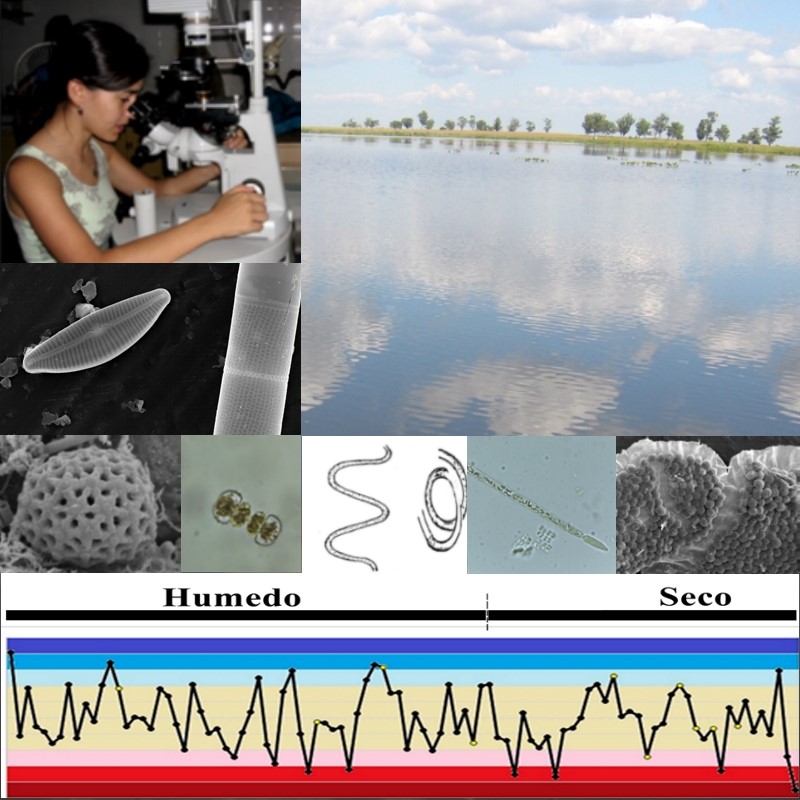Phytoplankton in the RAMSAR site “Esteros del Iberá” (Argentina): A comparison between drought and flood years
DOI:
https://doi.org/10.30972/bon.3327695Keywords:
Cyanobacteria, diversidad, floraciones algales, invasorasAbstract
This study analyzes the abundance, diversity, species richness, and evenness of phytoplankton in the Esteros del Iberá (Argentina) under two contrasting climatic conditions, encompassing both lentic and lotic environments. Analyses revealed that phytoplankton abundance in most of the Iberá system environments is unaffected by climatic variability; however, diversity, species richness, and evenness of phytoplankton were modified. In the large shallow lakes, Cyanobacteria predominated as components of the phytoplankton, with the highest density values in lagoon Iberá during the dry period. Two of the cyanobacteria species identified (Raphidiopsis raciborskii y Microcystis aeruginosa) are bloom-forming and potential producers of cyanotoxins, thus early detection of harmful species and sustainable management actions are recommended for tourist and conservation activities.
Downloads
References
Aguilera, A., Gómez, E. B., Kaštovský, J., Echenique, R. O. & Salerno, G. L. (2018). The polyphasic analysis of two native Raphidiopsis isolates supports the unification of the genera Raphidiopsis and Cylindrospermopsis (Nostocales, Cyanobacteria). Phycologia 57: 130-146. https://doi.org/10.2216/17- 2.1 DOI: https://doi.org/10.2216/17-2.1
Asselborn, V. M., Zalocar de Domitrovic, Y. & Casco, S. L. (1998). Estructura y variaciones del fitoplancton de la laguna Soto (Corrientes, Argentina). Boletín de la Sociedad Argentina de Botánica 33: 17–27.
Canziani, G. A., Ferrrati, R. S., Rossi, C. & Ruiz Moreno, D. (2006). The influence of climate and dam construction on the Iberá wetland, Argentina. Regional Environmental Change 6: 181-191. DOI: https://doi.org/10.1007/s10113-006-0018-9
Chorus, I. & Bartram, J. (1999). Toxic Cyanobacteria in water. A guide to their public health consequences, monitoring and management. Who, E & FN Spon, London. DOI: https://doi.org/10.1201/9781482295061
Chorus, I., Fastner, J. & Welker, M. (2021). Cyanobacteria and cyanotoxins in a changing environment: concepts, controversies, challenges. Water 13: 2463. https://doi.org/10.3390/w13182463. DOI: https://doi.org/10.3390/w13182463
Codd, G. A., Bell, S. G., Kaya, K., Ward, C. J., Beattie, K. A. & Metcalf, J. S. (1999). Cyanobacterial toxins, exposure routes and human health. European Journal of Phycology 34: 405-415. https://doi.org/10 .1080/09670269910001736462 DOI: https://doi.org/10.1080/09670269910001736462
Contreras, F. I., Ferrelli, F. & Piccolo, M. C. (2020). Impactos de eventos secos y lluviosos sobre cuerpos de agua periurbanos subtropicales: Aporte al ordenamiento del espacio urbano de Corrientes (Argentina). Finisterra 55: 3-22. https:// doi.org/10.18055/Finis19436
Contreras, F. I., Báez, C. T., Forastier, M., Baruzzo, M. N., Martínez, S. E. & Fernández, M. V. (2023). La calidad del agua del balneario de la laguna El Rincón, Caá Catí (General Paz, Corrientes). Período 2017-2023. Contribuciones Científicas GÆA 35: 7-16.
Contreras, F., Mavo Manstretta, G., Piccolo, M. & Perillo, G. (2021). Spatio-temporal variability monitoring of the floods in the center-west of the Buenos Aires Province (Argentina) using remote sensing techniques. Cuadernos de Investigación Geográfica 47: 337–354. https://doi.org/10.18172/ cig.4477 DOI: https://doi.org/10.18172/cig.4477
Contreras, F. I., Zurita, C., Smichowski, H., Diaz, A. A., Petkiebich, S. A., Kalafattich, S. & Gómez, C. (2022). Comparación de la recurrencia y severidad de la variabilidad climática en los extremos oriental y occidental de la provincia de Formosa (Rep. Argentina). Revista Senderos 3: 28-41.
Costa, S. M. & Azevedo, S. M. F. O. (1994). Implantação de um Banco de Culturas de Cianofíceas Tóxicas. Iheringia - Série Botânica 45: 69-74.
Cózar, A., García, C. M. & Gálvez, J. A. (2003). Analysis of plankton size spectra irregularities in two subtropical shallow lakes (Esteros del Iberá, Argentina). Canadian Journal of Fisheries and Aquatic Sciences 60: 411-420. https://doi. org/10.1139/f03-037 DOI: https://doi.org/10.1139/f03-037
Cózar, A., Gálvez, J. A., Hull, V., García, C. M., & Loiselle, S. A. (2005). Sediment resuspension by wind in a shallow lake of Esteros del Ibera (Argentina): a model based on turbidimetry. Ecological Modelling 186: 63-76. https://doi. org/10.1016/j.ecolmodel.2005.01.020 DOI: https://doi.org/10.1016/j.ecolmodel.2005.01.020
Dalu, T., Mwedzi, T. & Wasserman, R. J. (2022). Phytoplankton dynamics. En Dalu, T., & R. J. Wasserman (eds.), Fundamentals of Tropical Freshwater Wetlands, pp. 189-219. Elsevier. https:// doi.org/10.1016/B978-0-12-822362-8.00005-0 DOI: https://doi.org/10.1016/B978-0-12-822362-8.00005-0
Di Rienzo J. A., Casanoves F., Balzarini M. G., Gonzalez L., Tablada M. & Robledo C. W. InfoStat version (2020). Centro de Transferencia InfoStat, FCA, Universidad Nacional de Córdoba, Argentina. http://www.infostat.com.ar
Forastier, M. E. (2012). Diversidad y toxicidad de Cyanophyta (Cyanobacteria) del nordeste argentino. Tesis Doctoral, Universidad Nacional del Nordeste, Argentina. 219 pp.
Forastier, M. E. & Zalocar de Domitrovic, Y. (2014). Phytoplankton of the Iberá system. Advances in Limnology 65: 99-111. http://dx.doi. org/10.1127/1612-166X/2014/0065-0036 DOI: https://doi.org/10.1127/1612-166X/2014/0065-0036
Forastier, M. E., Zalocar Y., Andrinolo D. & Domitrovic H. A. (2016). Occurrence and toxicity of Microcystis aeruginosa (Cyanobacteria) in the Paraná River, downstream of the Yacyretá dam (Argentina). Revista de Biología Tropical 64: 203–211. https://www.scielo.sa.cr/pdf/rbt/v64n1/0034-7744-rbt-64-01-00203.pdf DOI: https://doi.org/10.15517/rbt.v64i1.8993
Frutos, S. M. (2017). La vida suspendida en el agua: La diversidad del zooplancton en el Iberá. En Poi, A. S. G (ed.), Biodiversidad en las aguas del Iberá, pp. 82- 98. EUDENE, Corrientes.
Graham, L. E. & Wilcox, L. W. (2000). Algae. Upper Saddle River, Prentice-Hall.
Guiry, M. D. & Guiry, G. M. (2021). AlgaeBase. Worldwide electronic publication, National University of Ireland, Galway, https://www.algaebase.org (Consulta 25-07-2024).
Kottek, M., Grieser, J., Beck, C., Rudolf, B. & Rubel, F. (2006). World map of the Köppen-Geiger climate classification updated. Meteorologische Zeitschrift 15: 259-263. http://koeppengeiger.vu-wien.ac.at/ present.htm DOI: https://doi.org/10.1127/0941-2948/2006/0130
Lancelle, H. G. (2003). Características físicas y químicas de las aguas del Iberá. pp. 71-84. En Poi de Neiff, A. S. G. (ed.), Limnología del Iberá, pp. 71-84. EUDENE, Corrientes.
Lee, R. E. (2008). Phycology. Four edition. Cambridge University Press. Cambridge. Lund, J. W. G., Kipling, C. & Le Cren, E. D. (1958). The inverted microscope method of estimating algal numbers and statiscal basis of estimating by counting. Hydrobiologia 11: 143-170. DOI: https://doi.org/10.1007/BF00007865
Martínez, S. E., Baruzzo, M. N., Smichowski, H., Forastier, M. E. & Contreras, F. I. (2021). El efecto de las precipitaciones en las características limnológicas en lagunas periurbanas. Revista Senderos 2: 122-135.
Neiff, J. J. (1977). Investigaciones ecológicas en el complejo de la laguna Iberá en relación a diversas formas de aprovechamiento hídrico. Actas del Seminario sobre medio ambiente y represas. OEA. Universidad de la República 1: 70-87.
Neiff, J. J. (2003). Distribución de la vegetación acuática y palustre del Iberá. En Poi de Neiff, A. S. G. (ed.), Limnología del Iberá: Características físicas, químicas y biológicas de las aguas, pp. 17-70. EUDENE, Corrientes.
Neiff, J. J. (2004). El Iberá ¿En peligro? – Fundación Vida Silvestre Argentina, Buenos Aires.
Neiff, J. J. & Casco, S. L. (2017). Lluvias y sequías: los cambios históricos de la vegetación. En POI, A. S. G (ed.), Biodiversidad en las aguas del Iberá, pp. 41-72. EUDENE, Corrientes.
Neiff, J. J. & Neiff, M. (2013). Evaluación de los impactos del cambio climático sobre el ecosistema natural y la biodiversidad. Medio Ambiente y Desarrollo 152: 1-58.
Poi, A. S. G., Neiff, J. J., Casco, L. S., Úbeda Sánchez, B. & Cozar Cabañas, A. (2017). El agua de los esteros, arroyos lagunas y ríos. En Poi A. S. G. (ed.), Biodiversidad en las aguas del Iberá, pp. 21-38. EUDENE, Corrientes.
Poi de Neiff, A. S. G., Neiff, J. J., Patiño, C. A., Ramos, A. O., Caceres, J. R., Frutos, S. M., & Verón, M. B. (1999). Estado trófico de dos lagunas en planicies anegables con áreas urbanas de la provincia de Corrientes. FACENA 15: 93-109.
Poi de Neiff, A. S. G. (2003). Limnología del Iberá: Características físicas, químicas y biológicas de las aguas. EUDENE, Corrientes, Argentina.
Poot-Delgado, C. A. & Pérez-Morales, A. (2023). Spatiotemporal variation of harmful phytoplankton in recreational beaches in Campeche, southeastern Gulf of Mexico Ciencias Marinas 49. https://doi. org/10.7773/cm.y2023.3389
Reynolds, C. S. (2006). Ecology of phytoplankton. Cambridge University Press. Rojas, B. M., Troccoli, L. & Díaz-Ramos, J. R. (2021). Bloom algal y abundancia de copépodos en el golfo de Cariaco, Venezuela (Caribe Suroriental). Intropica 16: 133-152. https://doi.org/10.21676/23897864.4010 DOI: https://doi.org/10.21676/23897864.4010
Roset, J., Aguayo, S. & Muñoz, M. J. (2001). Detección de cianobacterias y sus toxinas. Una revisión. Revista de Toxicología 18: 65-71.
Sabater, L., Fanceschini, M. C., Gallardo, L., Coronel, J. & Perez, A. (2022). Disentangling vegetation structure effect on invertebrate communities in contrasting growth periods in subtropical protected wetlands of Argentina. Anais da Academia Brasileira de Ciências 94. https://doi. org/10.1590/0001-3765202220210965. DOI: https://doi.org/10.1590/0001-3765202220210965
Salmaso, N. & Tolotti, M. (2021). Phytoplankton and anthropogenic changes in pelagic environments. Hydrobiologia 848: 251-284. https://doi. org/10.1007/s10750-020-04323-w DOI: https://doi.org/10.1007/s10750-020-04323-w
Sellner, K. G., Doucette, G. J. & Kirkpatrick, G. J. (2003). Harmful algal blooms: causes, impacts and detection. Journal of Industrial Microbiology and Biotechnology 30: 383-406. https://doi.org/10.1007/ s10295-003-0074-9 DOI: https://doi.org/10.1007/s10295-003-0074-9
Shannon, C. E. & Weaver, W. (1963). The mathematical theory of communication. Illinois. University Press, Urbana.
Shapiro, S. S. & Wilk, M. B. (1965). An analysis of variance test for normality (complete samples). Biometrika 52: 591-611. doi:10.1093/biomet/52.3-4.591.JSTOR 2333709 MR 205384. DOI: https://doi.org/10.1093/biomet/52.3-4.591
Smichowski, H., Contreras, F. I. & Giese, A. C. (2022). Seguimiento de la extensión areal de los humedales subtropicales del noreste de Argentina mediante la aplicación de Google Earth Engine. Investigaciones Geográficas 78: 131-152. https://doi.org/10.14198/ INGEO.21343 DOI: https://doi.org/10.14198/INGEO.21343
Úbeda, B., Di Giacomo, A. S., Neiff, J. J., Loiselle, S. A., Poi, A. S. G., Galvez, J. A. & Cózar, A. (2013). Potential effects of climate change on the water level, flora and macro-fauna of a large neotropical wetland. PloS one 8: e67787. https:// doi.org/10.1371/journal.pone.0067787 DOI: https://doi.org/10.1371/journal.pone.0067787
Utermöhl, H. (1958). Zur Vervollkommnung der quantitativen Phytoplankton-Methodik. Mitteilungen der Internationale Vereinigung für Theoretische und Angewandte. Limnologie 9: 1-38. DOI: https://doi.org/10.1080/05384680.1958.11904091
Vicente-Serrano, S. M., Beguería, S. & LópezMoreno, J. I. (2010). A multiscalar drought index sensitive to global warming: The standardized precipitation evapotranspiration index. Journal of Climate 23: 1696-1718. https://doi. org/10.1175/2009JCLI2909.1 DOI: https://doi.org/10.1175/2009JCLI2909.1
Vidal, L. & Kruk, C. (2008). Cylindrospermopsis raciborskii (Cyanobacteria) extends its distribution to Latitude 34 53’S: taxonomical and ecological features in Uruguayan eutrophic lakes. PanAmerican Journal of Aquatic Sciences 2: 142-151.
Watson, S. B., Whitton, B. A., Higgins, S. N., Paerl, H. W., Brooks, B. W., & Wehr, J. D. (2015). Harmful algal blooms. En Wehr, J. D., Sheath, R. G. & J. P. Kociolek (eds.), Freshwater Algae of North America, pp. 873-920. Academic Press. San Diego. https://doi. org/10.1016/B978-0-12-385876-4.00020-7. DOI: https://doi.org/10.1016/B978-0-12-385876-4.00020-7
Zalocar de Domitrovic, Y., Asselborn, V. M. & Casco, S. L. (1998a). Variaciones espaciales y temporales del fitoplancton en un lago subtropical de Argentina. Revista Brasileira de Biologia 58: 359-382. DOI: https://doi.org/10.1590/S0034-71081998000300003
Zalocar de Domitrovic, Y., Casco, S. L. & Asselborn, V. M. (1998b). Estudio de la biomasa y diversidad del fitoplancton de la laguna Paiva, Corrientes (Argentina). Physis 55:1-13.
Zalocar de Domitrovic, Y. & Forastier, M. E. (2008). Las cianobacterias del nordeste argentino: caracteres generales e importancia ecológica. En Casco, S., Basterra, I. & J. J. Neiff (eds.), Manual de biodiversidad de Chaco, Corrientes y Formosa, pp. 57-77. Universidad Nacional del Nordeste, Corrientes.
Zalocar de Domitrovic, Y. (1999). Estructura y dinámica del fitoplancton en la cuenca del eje potámico Paraguay-Paraná (Argentina). Tesis Doctoral, Universidad Nacional de Córdoba, Argentina. 375 pp.
Zalocar de Domitrovic, Y. (2003). Fitoplancton de lagunas y cursos de agua del sistema Iberá. En Poi de Neiff, A. S. G. (ed.), Limnología del Iberá: Características físicas, químicas y biológicas de las aguas, pp. 85-142. EUDENE, Corrientes.

Downloads
Published
How to Cite
Issue
Section
License
Copyright (c) 2024 Bonplandia

This work is licensed under a Creative Commons Attribution 4.0 International License.
Declaration of Adhesion to Open Access
- All contents of Bonplandia journal are available online, open to all and for free, before they are printed.
Copyright Notice
- Bonplandia magazine allows authors to retain their copyright without restrictions.
- The journal is under a Creative Commons Attribution 4.0 International license.














.jpg)


